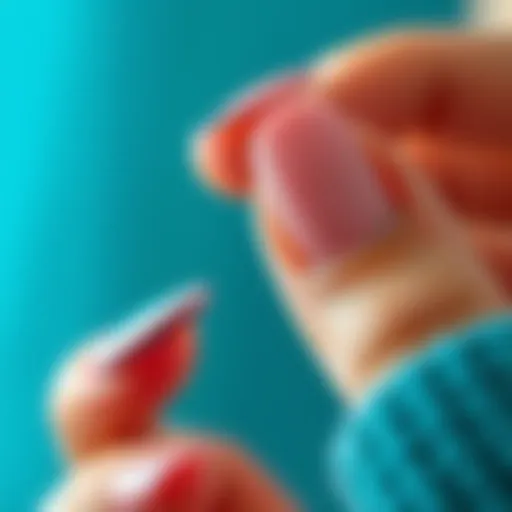Exploring the Versatility of Colorful Flannel
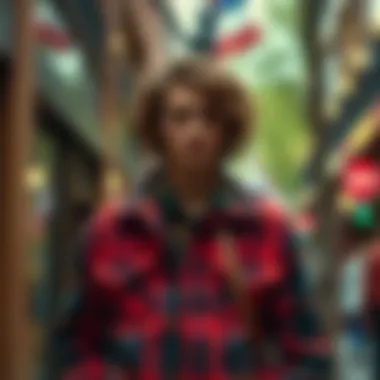

Intro
Flannel, once merely a practical fabric, has evolved into a staple of modern wardrobes, embraced for its warmth, comfort, and striking vibrancy. Not only does colorful flannel provide a burst of personality to any outfit, but it also carries with it a tapestry of history, culture, and societal shifts. Today, we uncover how flannel transitioned from workwear used by lumberjacks and farmers into a beloved, multifaceted material celebrated across fashion runways and everyday style.
In this exploration, we will dissect various aspects of colorful flannel, including its historical journey, its current place in fashion, styling tips, and its significance in sustainable practices. This article aims to serve as a comprehensive guide for fashion designers, stylists, bloggers, and educators, enhancing their understanding of a fabric that wears many hats.
Fashion Trends
Current Seasonal Trends
In the bustling world of fashion, colorful flannel has established itself as a perennial favorite, particularly during the fall and winter months. This fabric encapsulates warmth, both in texture and hue. Designers this season showcase bold checks, large plaids, and vivid colors that defy traditional notions of flannel. The focus has shifted to how these vibrant patterns can energize outfits, providing a playful yet cozy element that stands out.
A key trend is layering colorful flannel pieces with lighter materials. Pairing a bright flannel shirt under a tailored coat or styling a flannel skirt with chic knee-high boots are just a few ways to embrace this trend. Moreover, oversized flannels make a statement not just in colors but also in fit, inviting a sense of relaxed confidence.
Influential Fashion Icons
Fashion icons have played a significant role in popularizing colorful flannel, often redefining its image. Take, for example, Pharell Williams, whose signature style frequently features plaid flannel shirts, unbuttoned and draped nonchalantly over tees. He effortlessly merges casual comfort with streetwear aesthetics, pushing the boundaries of how flannel can be styled.
On the female front, the likes of Billie Eilish illuminate the scene, often opting for oversized, checkered flannel jackets that not only elevate her casual look but also convey a message of self-expression. Such icons have inspired a new generation of fashion enthusiasts to incorporate colorful flannel into their everyday ensembles, signaling that casual doesn't have to mean bland.
"Colorful flannel transforms the mundane into a melting pot of personal style, allowing for both comfort and creativity."
Styling Tips
Outfits for Different Occasions
Colorful flannel is versatile. From casual get-togethers to more formal gatherings, the potential for chic outfits is enormous. Here are a couple of ideas:
- Casual Day Out: A fitted bright blue flannel shirt paired with skinny jeans and ankle boots creates a relaxed vibe perfect for brunch or shopping.
- Office-Ready: Select a muted plaid in soft colors for a shirt dress, belting it at the waist for a polished silhouette. Layer with a tailored blazer to keep it professional yet trendy.
- Evening Out: Go for an oversized flannel in bold colors. Wear it open over a sleek turtleneck and leather trousers for a contemporary look that merges comfort with elegance.
Mix and Match Techniques
When it comes to styling colorful flannel, the magic lies in its ability to pair with various fabrics and patterns. Here are some ways to think outside the box:
- Contrasting Textures: Mix flannel with leather or denim; the contrast in textures creates visual interest while maintaining a cohesive look.
- Layering Patterns: Don't shy away from combining patterns. A striped top worn under a flannel shirt can add depth if styled thoughtfully.
- Accessorizing Smartly: Let accessories elevate the flannel integration. Statement jewelry, vibrant scarves, or even hats can transition a simple flannel outfit into a fashion-forward statement.
Throughout this journey into the colorful world of flannel, its rich history and versatility stand out remarkably. As we continue, we will delve deeper into sustainability practices related to the fabric, ensuring this exploration wraps up with a holistic view on its prominence today.
Prolusion to Colorful Flannel
Flannel often evokes thoughts of warmth and comfort, wrapped snugly around us like a dependable friend on a chilly day. The term itself has become almost synonymous with effortless style and casual wear. In the realm of fashion, the introduction of colorful flannel presents not just a shift in palette but a transformation in how we perceive this versatile fabric.
With a history rooted deeply in practical use, the colorful variations of flannel have transcended their original purpose, becoming a staple in contemporary wardrobes. They possess the duality of being functional yet stylish, serving a myriad of fashion needs from the everyday casual look to a more polished appearance. Overall, understanding the nuances of colorful flannel is significant for anyone involved in fashion design or retail.
Factors such as fabric blends, printing techniques, and marketing strategies all come into play when considering the relevance of colorful flannel in modern fashion. For designers, it opens up avenues for creativity; for retailers, it represents both a sales opportunity and a cultural statement. The benefits of engaging with this topic extend beyond the aesthetic, delving into cultural implications and economic factors. An exploration of colorful flannel reinforces its position not only as a clothing material but also as a concept that resonates through different layers of society.
Definition and Characteristics
Colorful flannel, at its core, is a textile made from loosely spun wool or cotton fibers, offering a soft feel and warmth that is both comforting and inviting. Its most notable characteristic is the brushed finish, giving it that distinctive texture revered by many. Yet, it’s the vibrancy of colors and patterns that breathe new life into traditional flannel, making it a canvas for self-expression.
- Material: Flannel can be made from various materials including wool, cotton, or synthetic fibers. Cotton flannel is the most prevalent in contemporary applications, celebrated for its breathability and versatility.
- Texture: Flannel’s brushed texture creates a cuddly sensation against the skin, ideal for layering in colder seasons. This tactile quality enhances not only comfort but also style adaptability.
- Patterns: The emergence of colorful flannel has led to an array of designs from classic plaids to contemporary geometric patterns. Each pattern tells a story and captures a mood, ranging from rustic charm to bold modernity.
- Weight: The fabric comes in various weights, offering options suitable for different climates and seasons. A heavier flannel is ideal for winter, while lighter varieties are perfect for transitional seasons.
In summary, colorful flannel is defined by a combination of material choice, texture, diverse patterns, and weight variations. Those engaged in fashion, be it designers or retailers, must understand these characteristics to effectively utilize flannel as a multifaceted material in their collections and offerings.
Historical Context
Understanding the historical context of colorful flannel is vital as it lays the groundwork for appreciating its current status in fashion. Flannel has roots that stretch back centuries, evolving from a workman's fabric into a sought-after style statement. This transformation reveals trends in societal needs, fashion evolution, and cultural significance surrounding textiles. Unpacking these elements grants insight into how the fabric gained a multifaceted nature that is still embraced today.
Origins of Flannel Fabric
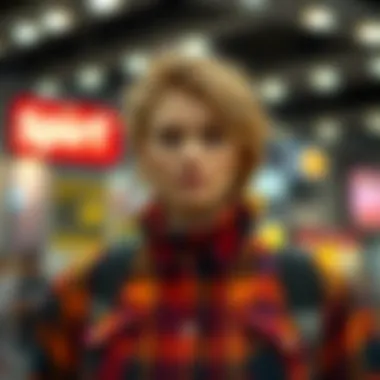

Flannel is believed to have originated in Wales during the 17th century. Initially, it was made from wool, crafted for warmth and durability. The early weavers utilized coarse fibers that provided a fabric capable of withstanding the harsh climates of the British Isles. Interestingly, the term "flannel" has Welsh roots, derived from the word "felin," a term used for a woolen cloth.
As flannel spread, it adapted to various uses, both practical and decorative. Clothing made from this fabric quickly became favored among those needing warmth, such as farmers and laborers. Its reputation grew, particularly due to the comfort it offered during manual labor, balancing functionality and ease of wear.
"Flannel symbolizes resilience and adaptability, much like the cultures which embraced it over the centuries."
Evolution Through the Decades
Over the decades, flannel has experienced a significant metamorphosis that reflects changing fashion sensibilities. In the late 19th and early 20th centuries, with the rise of industrialization, flannel became popular among factory workers. The fabric's capability to keep individuals warm while allowing ease of movement turned it into an essential component of their daily attire.
As the years rolled on, particularly during the 1960s and 1970s, flannel re-emerged within the realms of counterculture and rock music. Bands like Nirvana brought the fabric into the spotlight, associating it with a laid-back, rebellious spirit. The grunge movement made plaid flannel shirts emblematic of a generation, escaping societal norms while embodying a certain casual chicness.
Throughout the 1980s and 1990s, flannel saw its popularity soar in alternative fashion circles, evolving into myriad styles and patterns that would appeal to a broad audience. Today, it is available in endless variations, dueling between vintage charm and contemporary vibes, making it a versatile staple in both casual and semi-formal wardrobes. Whether paired with jeans or layered under blazers, colorful flannel is emblematic of personal style and aesthetic storytelling.
In essence, the history of flannel is reflected in its myriad of forms. From humble labor-starting points to high-fashion presentations, flannel manages to charm across generations, proving itself as a flexible, timeless fabric.
Cultural Significance
Colorful flannel holds a significant place in various cultures across the globe, not merely as a fabric but as a symbol of identity, comfort, and community. This section dives into the rich tapestry of meanings attached to flannel, unraveling the benefits and considerations surrounding its cultural significance.
Flannel has transitioned through time, serving different purposes for different groups. In North America, for instance, flannel shirts have long been associated with the rugged outdoor lifestyle, reflecting a connection to nature and simplicity. Traditionally worn by lumberjacks and farmers, these shirts have come to represent a certain rugged masculinity. However, in today’s world, they've crossed the bounds of outdoor gear and forged a path into urban fashion, becoming a staple in streetwear and casual settings.
Furthermore, the vibrant colors and patterns found in colorful flannel can denote various cultural identities. For instance, specific plaids can represent regional pride in Scotland, while in other areas, completely different patterns exemplify local traditions or affiliations. The fabric thus acts as a canvas, portraying the rich diversity within and across cultures.
"Flannel does not just keep you warm; it wraps you in stories, ties you to your roots, and invites you to share in a communal experience across cities and continents."
Flannel in Various Cultures
North American Traditions
In the United States and Canada, flannel is often linked to informal settings and has become synonymous with outdoor activities and pursuits like hiking and camping. This practical cloth bears the marks of various subcultures. In punk and grunge fashion, for instance, oversized plaid flannel shirts were adopted as symbols of rebellion against mainstream culture in the 1990s. The blend of comfort and defiance speaks volumes about an era when youth sought authenticity through their personal styles.
European Connections
Conversely, in places like Wales, flannel has deep historical roots dating back centuries. It was used not only in clothing but also in blankets and other textiles. In Wales, the Flannel is celebrated; it’s not just a material—there’s even a song titled "Cymru a Flannel" which speaks of love for the fabric and the cherishing of one’s heritage.
Indigenous Cultures
Among Indigenous peoples, colorful flannel has also found its way into modern attire, often through a lens of adaptation. The fabric is frequently used in crafting traditional outfits or modern interpretations that honor both cultural identity and contemporary sensibilities. Wearing flannel can serve as a reminder of one’s heritage while framing it within current fashion trends.
Benefits of Understanding Cultural Context
- Respect: Recognizing the significance of flannel in various cultures fosters a sense of respect and appreciation for diversity.
- Marketability: Understanding these cultural dimensions can improve marketing approaches for businesses, tapping into specific narratives that resonate with certain demographics.
- Innovation: Fashion designers and retailers can find inspiration in cultural narratives and aesthetics, leading to innovative designs that truly speak to the heart of cultural identity.
In sum, colorful flannel is not merely fabric; it embodies stories of resilience and community spanning across generations and continents. This deep-rooted cultural significance highlights the potential it holds for modern applications, allowing for a fusion of tradition with contemporary style.
Types of Colorful Flannel
The discussion around colorful flannel cannot avoid an exploration of its various types. Understanding these categories helps not only in styling but also in appreciating the fabric's rich attributes. The diversity within colorful flannel makes it an incredibly versatile option for different wardrobes. Each type offers unique aesthetic and functional benefits, and combining these can create various looks.
Plaid Patterns
When it comes to flannel, plaid patterns hold a special place. These designs are often intertwined in the fabric's identity, reflecting its utilitarian past and broad appeal today. The checkered designs are a nostalgic nod to outdoor adventures and rustic living—a vibe that's particularly resonant in autumn and winter styles.
Plaid flannel can come in a range of colors, from muted earth tones to bright, vibrant hues. This noteworthy range allows for creativity in layering. For instance, a red and black plaid shirt pairs well with denim jeans and boots for a classic, rugged outfit. It’s not just a fashion statement; it captures a lifestyle sentiment. Moreover, the geometric angles of plaid allow for interesting cut and sewing patterns in garment construction, making it a favored choice among designers looking to create visually striking pieces.
Solids and Monochromes
On the flip side, solids and monochromes provide a different but equally important element to colorful flannel. These styles strip away busy patterns in favor of bold colors that catch the eye without the fuss of complex designs. Solid flannel tops, for example, can be easily paired with patterned bottoms or accessories, making them a staple for both casual and more formal ensembles.
Beyond aesthetics, solid flannel options communicate minimalism, allowing wearers to express their style in a more subtle manner. For fashion designers and stylists, these pieces are a playground for experimentation, providing a clean canvas to play with textures and layering techniques. The versatility offers endless possibilities, from fitting work attire to weekend brunch outings, solid flannel effortlessly transitions across various social contexts.
Novelty and Artwork Designs
Then we have novelty and artwork designs. These stylish variations take colorful flannel to a whole new level. From whimsical motifs to intricate prints, novelty flannels can showcase everything from abstract patterns to cultural references. Such designs often appeal to younger audiences or those wanting to express their individuality through fashion.
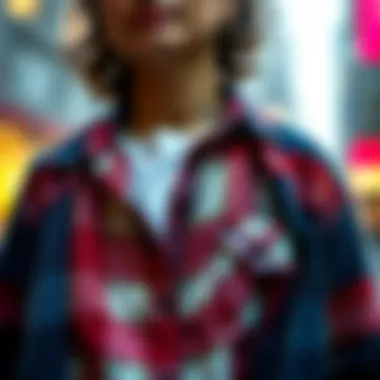

The uniqueness of novelty flannel serves as a conversation starter. Sometimes, what's on a shirt can speak volumes about personality or interests. For instance, a flannel adorned with artistic depictions of popular culture draws attention and provides layers of meaning for the wearer. Moreover, these designs might challenge traditional perceptions of flannel, pushing it beyond the realms of casual wear into realms of art and self-expression. Designers aiming for a fresh twist on classic styles will find this type particularly exciting, as it opens up a world of creative possibilities.
Styling Colorful Flannel
Styling colorful flannel transcends mere fashion choices; it's a form of self-expression that marries comfort with creativity. Flannel, often associated with casual wear, can be adapted for various settings, making it a versatile staple in any wardrobe. This section offers insights into how to truly harness the potential of colorful flannel, thus enhancing one's personal style while keeping practicality in mind.
Layering Techniques
Layering is an art. When it comes to colorful flannel, the technique not only adds warmth but also depth to an outfit. Here are several methods to layer flannel effectively:
- Classic Overcoat or Jacket: A vibrant flannel shirt underneath a solid-colored coat creates a striking contrast, allowing the shirt's colors to pop. This contrast is especially eye-catching during a chilly evening.
- Sweater Combination: Pair a lightweight flannel with a fitted sweater. This creates visual interest through texture and color variations, thus making the outfit feel multi-dimensional.
- Turtleneck Foundation: A fitted turtleneck under a colorful flannel shirt can be a sleek look. Not only will it keep the cold at bay, but it also introduces a dapper vibe.
The beauty of layering flannel lies in the possibility to mix colors and patterns while still remaining stylish. As the saying goes, "the more, the merrier," and that rings true with flannel. Use neutral layers to tone down an exceptionally bright flannel, balancing the entire look.
Casual Versus Formal Looks
Flannel can adapt to any occasion, blurring the lines between casual and semi-formal. Here’s how this fabric can be styled for both atmospheres:
- Casual Look: For a laid-back vibe, opt for a relaxed fit flannel shirt paired with distressed jeans or leggings. Add ankle boots or sneakers for comfort. This combo is perfect for weekend adventures or a casual meet-up with friends.
- Formal Look: To elevate flannel for a more polished look, choose a tailored flannel shirt tucked into high-waisted trousers. Completing this with brogues or sleek loafers can turn heads at a business casual gathering or even a more formal event. Layering with a blazer over the flannel increases sophistication.
The key takeaway is recognition of the versatility of flannel, which allows wearers to switch from casual to formal effortlessly.
Accessorizing with Flannel
Accessorizing colorful flannel is where personal style shines. Through thoughtful accessory choices, you can completely transform the vibe of your flannel outfit. Below are suggestions to enhance your ensemble:
- Scarves: A bold scarf—perhaps in a complementary color—can tie the outfit together beautifully, adding warmth as well as style.
- Hats: Fedoras or beanies can complement flannel shirts. They add a certain flair, transforming a simple look into a fashion statement.
- Jewelry: Minimalistic jewelry works wonders for flannel. Think thin gold or silver necklaces worn over a collared flannel shirt. Avoid overly large pieces that can clash with the fabric’s texture.
- Bags: The type of bag you choose can make or break the outfit. A leather crossbody bag or backpack can add a chic touch, while a canvas tote speaks to a more laid-back aesthetic.
Ultimately, the art of accessorizing rests in balancing the outfit without overwhelming the flannel's unique patterns and colors. It’s about finding harmony between different elements, creating a look that’s uniquely yours.
Practical Applications in Fashion
The colorful flannel has carved out a distinct niche in the fashion realm, earning its status not just as a comfortable fabric but also as a versatile player in wardrobes across the globe. The appeal of flannel extends beyond mere aesthetics; it introduces practicality and warmth while allowing self-expression through color and design choices. Understanding its practical applications in fashion can help designers and stylists better curate looks that cater to diverse audiences.
Seasonal Trends
Flannel tends to enjoy a particular spotlight during certain seasons, particularly fall and winter. Its soft texture and insulating qualities make it a favored choice for colder months. Here are a few important points regarding seasonal trends in colorful flannel:
- Layering for Warmth: As temperatures drop, flannel shirts and jackets become perfect layers. They can buffer the chill effectively while looking effortlessly stylish. For instance, pairing a boldly patterned flannel shirt beneath a wool coat enhances not only warmth but also visual interest to an outfit.
- Brightening Up Winter: While many gravitate towards dark shades in the winter, colorful flannel offers a refreshing contrast. Vibrant hues can uplift the generally muted tones of winter wardrobes. Imagine a bright red or electric blue flannel peeking from under a heavy parka; it injects a bit of cheer in an otherwise dreary season.
- Spring Restorations: As winter gives way to spring, flannel finds its place in transitional weather. Lightweight flannels in pastel shades can be paired with shorts or skirts, making them adaptable. Using print variations, like floral patterns on flannel, can also align with spring's theme of renewal.
"Fashion trends come and go, but flannel has an unparalleled staying power rooted in comfort and utility."
Key Considerations for Seasonal Styling
- Material Weight: Not all flannels are created equal; their weight varies. Lighter fabrics are excellent for layering during spring, while thicker options are vital for winter coats.
- Color Selection: Seasonal color palettes can guide decisions. Earth tones might draw attention in fall, while brighter colors can signify the joy of spring.
- Print Variety: From classic plaid to unique modern prints, the variety in flannel designs can influence styling choices. Mixing prints carefully or opting for a statement piece can lead to dynamic looks.
The practical applications of colorful flannel in fashion revolve around its adaptability across seasons, making it an essential fabric for designers and consumers alike. As the trends shift, the presence of flannel continues to assure wearers of both comfort and style, proving itself as a timeless staple in an ever-changing fashion landscape.
Care and Maintenance
Taking care of colorful flannel is as vital as picking the right patterns. Proper care ensures the fabric remains vibrant and comfortable over time. With flannel receiving its share of limelight in wardrobes, understanding how to maintain its charm is key for anyone who appreciates this versatile textile. Following a few simple practices can significantly extend the lifespan and integrity of your flannel garments.
Washing and Drying
When it comes to washing colorful flannel, gentle treatment goes a long way. Here are some essential tips to keep in mind:
- Cold Water Wash: Always opt for cold water when washing flannel. Hot water can cause shrinking and fade colors. Using your machine's gentle cycle can prevent excess agitation, which often leads to pilling.
- Mild Detergent: Choose a mild detergent that doesn't contain harsh chemicals. This will ensure the colors remain true to their original hue and the fabric itself stays soft.
- Avoid Bleach: Steer clear of bleach, as it not only lightens colors but also damages the fibers. If stains are a concern, consider using a stain remover that is fabric-safe instead.
- Separate Colors: Wash dark colors separately from light ones to prevent color bleeding. This is especially important for the vibrant patterns typical of colorful flannel.
After washing, it’s wise to take precaution with drying:
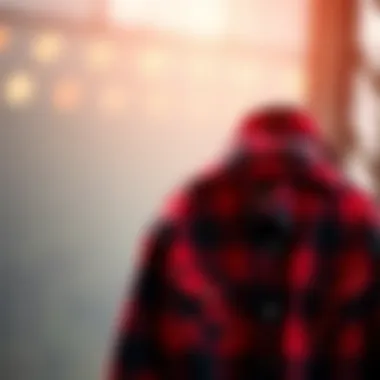

- Air Dry Whenever Possible: Flannel benefits from air drying. Simply hang it up or lay it flat on a clean surface. This method helps to preserve its shape and prevents any potential shrinkage that might occur in the dryer.
- If Using a Dryer: If you're pressed for time, opt for a low heat setting, and take the garments out while they are still slightly damp. This will provide a softer finish and make the fabric easier to iron.
"Care and maintenance are the unsung heroes of any cherished item in your closet. Treat your flannel right, and it will serve you well for years."
Ironing and Storing
When it comes to keeping your colorful flannel looking sharp, proper ironing and storage methods are also important:
- Iron While Damp: For best results, iron flannel while it's still slightly damp. This makes the fabric easier to handle and ensures a smoother finish.
- Use a Low Temperature Setting: Set your iron to a low-medium heat. High temperatures can scorch the fabric, compromising its quality. A pressing cloth can be used to protect the fabric as well.
- Avoid Steaming: While steaming might seem like an easy way to reduce wrinkles, it can lead to water spots. Instead, a gentle press will do the trick.
When it comes to storing your flannel, consider these guidelines:
- Fold Neatly: To prevent creases, fold flannel items instead of hanging them. This helps maintain their shape and prevents stretching.
- Climate Control: Store flannel in a cool, dry place. Avoid damp areas to reduce the risk of mold and musty odors. Acid-free tissue paper can also be used to help maintain the fabric’s shape during storage.
- Moth Prevention: Use cedar blocks or lavender sachets in your storage area. These natural alternatives help deter moths without introducing harsh chemicals into your storage.
By putting thought into washing, drying, ironing, and storing, flannel can remain a staple in your wardrobe for many seasons. Taking these simple steps can make a world of difference in how the fabric wears and retains its original flair.
Sustainability Considerations
In today's fast-paced fashion landscape, the conversation around sustainability is changing the way we view fabrics—including colorful flannel. Once regarded primarily for its aesthetic appeal and comfort, flannel now finds itself in the spotlight for its environmental impact and ethical considerations. As a result, understanding sustainable practices in fabric use is crucial for anyone involved in fashion design, styling, or retail.
The importance of sustainability in the context of colorful flannel encompasses various elements, such as the materials used, production methods, and the lifecycle of the garment. By making informed choices, designers and consumers can contribute significantly to reducing waste and pollution. Here are a few aspects worth noting:
- Resource Efficiency: Choosing eco-friendly materials can reduce the depletion of natural resources. Organic cotton and recycled fibers, for example, require less water and energy compared to conventional methods.
- Chemical Reduction: Eco-friendly production limits the use of harmful dyes and chemicals, which can leak into waterways and harm local ecosystems. This is increasingly relevant as awareness around pollution grows.
- Circularity: Emphasizing a circular economy—where garments are reused and recycled—can extend the life of flannel clothing beyond its initial sale, minimizing environmental strain.
"Fashion should not only look good but also do good. Every choice we make echoes through generations."
By considering these factors, fashion professionals can ensure that colorful flannel doesn't only enrich wardrobes but also respects our planet. This shift towards sustainable practices reflects a growing consciousness among consumers who are keen to support brands that prioritize environmental stewardship.
Eco-Friendly Materials
The quest for sustainable flannel begins with the materials themselves. Choosing eco-friendly options can make a real difference in the production and lifecycle of colorful flannel. Here are some materials gaining traction in this arena:
- Organic Cotton: Grown without synthetic fertilizers or pesticides, organic cotton helps preserve soil health and biodiversity.
- Bamboo Fabric: This fast-growing grass is often used to create soft and breathable flannel. Its cultivation typically requires less water and no chemicals, promoting a cleaner environment.
- Recycled Polyester: Sourced from post-consumer plastic bottles, recycled polyester reduces reliance on petroleum-based textiles and minimizes landfill waste.
As a designer or stylist, opting for these materials not only enhances your collection but also sends a strong message to your clientele about the importance of sustainability in fashion.
Second-Hand Flannel and Thrift Culture
The increasing popularity of thrift culture represents a significant shift in consumer behavior and attitudes. Second-hand flannel pieces are becoming prized finds. Embracing second-hand flannel means more than just economic savings—it symbolizes a commitment to sustainability.
Consider the following benefits of incorporating second-hand flannel into your wardrobe:
- Reduced Waste: Each second-hand purchase is one less item that ends up in a landfill, helping to combat the fast fashion crisis.
- Unique Style: Vintage flannel often features rare patterns and unique designs that may no longer be available in mainstream fashion.
- Saves Resources: Buying pre-owned items decreases the demand for new materials, which can be resource-intensive to produce.
By championing thrift culture, designers and stylists can foster a greater appreciation for colorful flannel not only as a clothing choice but as a lifestyle that values sustainability. In a world driven toward consumerism, shifting focus to second-hand treasures embodies a forward-thinking approach that can influence the next generation of fashion enthusiasts.
Through thoughtful engagement with eco-friendly materials and by supporting thrift and second-hand culture, the fashion community can contribute to a more sustainable future, creating a legacy that respects both style and the environment.
Ending
In wrapping up our exploration of colorful flannel, it's apparent that this fabric is more than just a textile—it's a cultural touchstone, a seasonal staple, and a versatile style choice. The journey of flannel from its origins as a practical fabric for laborers to its current status as a fashion icon underscores its adaptability across time and contexts. Each pattern, each vivid hue, tells a story of personal expression and societal trends, making colorful flannel not just clothing, but a canvas for artistic and cultural identity.
The Enduring Appeal of Colorful Flannel
The allure of colorful flannel lies in its unique ability to bridge comfort with style. Few fabrics can boast such a rich palette of patterns, from classic plaids to extraordinary custom prints. This cultural versatility allows individuals to express themselves—whether they're dressing for a casual outing or layering up for a chic evening look.
"Flannel has a way of stitching together our past and present, making it more than just a fabric, but a part of who we are."
Key benefits to consider when reflecting on the charm of colorful flannel include:
- Versatility: Works well for all seasons; light enough for spring and summer, yet warm for fall and winter.
- Accessibility: Available in numerous price points, ensuring that style doesn't have to break the bank.
- Sustainability: Increasingly, brands are turning to eco-friendly materials, making flannel choices that are conscious of the environment.
- Timelessness: Flannel has stood the test of time, with its appeal persisting through various fashion decades.
Whether it’s a laid-back weekend vibe or dressed up for a night on the town, colorful flannel can adapt seamlessly. Moreover, its integration in diverse cultural practices emphasizes its universal nature, showing us how fashion can unite people.
In the days ahead, colorful flannel is poised to continue its journey, evolving with trends while holding onto its roots. For fashion designers, stylists, bloggers, and retailers, understanding this fabric not just as a product, but as a symbol of identity and expression is crucial. The ongoing fascination with flannel reminds us that in fashion—as in life—versatility and authenticity are key.











